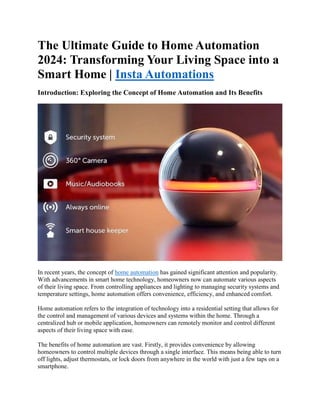The Ultimate Guide to Seamless Smart Home Integration: Elevate Your Living Space provides comprehensive insights and practical tips to effortlessly incorporate smart technologies into your home. Discover how to enhance your living experience through seamless integration of smart devices and systems.
From voice-controlled assistants to automated lighting, this guide offers expert advice for transforming your home into a modern, connected haven. Explore the endless possibilities of smart home integration and unlock the full potential of your living space.

Credit: www.slideshare.net
Why Smart Home Integration?
Smart home integration offers both efficiency and convenience, making our lives easier and more comfortable. By seamlessly connecting various devices, we can streamline our daily tasks and enjoy a hassle-free living experience.
In terms of efficiency, smart home integration allows us to automate routine activities. With just a few taps on our smartphones, we can adjust the thermostat, control lighting, or even start brewing a fresh pot of coffee before we step out of bed in the morning.
Moreover, smart home integration enhances security and safety. We can remotely monitor our homes through security cameras and receive instant alerts if any unusual activity is detected. Integration with smart locks and doorbells provides added convenience by allowing us to grant access to trusted individuals even when we are away.
All these features make smart home integration an essential part of modern living, ensuring a seamless and elevated experience in our homes.
Key Components Of A Smart Home
Smart Lighting, Smart Thermostats, and Voice Assistants are essential elements of a seamlessly integrated smart home. With Smart Lighting, you can effortlessly control and customize the brightness, color, and timing of your lights, enhancing both ambiance and energy efficiency. Smart Thermostats allow you to remotely adjust the temperature, ensuring optimal comfort and potentially reducing utility costs. Voice Assistants such as Alexa or Google Assistant enable convenient hands-free control of various devices throughout your home, from adjusting the thermostat to playing your favorite music.
Integrating these components into your living space creates a truly connected and convenient experience. When you arrive home, your lights automatically turn on, your thermostat adjusts to your preferred temperature, and your favorite playlist greets you as you walk through the door. And with voice commands, you can effortlessly control these features, creating a truly personalized and interactive home environment.
Choosing The Right Smart Home Devices
The right smart home devices can transform your living space into a seamless and convenient environment. When choosing these devices, it's important to consider compatibility and interoperability. Ensuring that the smart devices you select work well together can eliminate any frustration and ensure smooth integration. Quality and reliability are also essential factors to consider. Investing in well-established brands and reading customer reviews can help you make an informed decision. Additionally, prioritize user-friendliness to ensure ease of use for everyone in your household, including younger and older members. Look for devices with intuitive interfaces and straightforward setup processes. By carefully considering these factors, you can confidently select smart home devices that effortlessly elevate your living space.
Setting Up Your Smart Home Network
When setting up your smart home network, it is important to consider the different connectivity options available. Three popular choices for smart home communication are Wi-Fi, Zigbee, and Z-Wave. Understanding the differences between these options will help you make an informed decision.
Wi-Fi is a common and familiar option that most households already have. It provides a strong and reliable connection, but it can be susceptible to congestions and interference in crowded areas. Zigbee, on the other hand, uses low-power wireless technology and is ideal for connecting multiple devices over a large area. It offers a robust and mesh-like network that enhances your smart home's reach.
Z-Wave is another wireless technology that focuses on low-power consumption and long-range communication. It offers a wider range of compatible devices, making it an excellent choice for expanding your smart home setup. Regardless of which option you choose, proper router placement and configuration are crucial for optimal smart home performance.
Place your router in a central location and minimize obstructions to ensure good coverage throughout your living space. Additionally, configure your router's settings to optimize signal strength and security. By considering the pros and cons of Wi-Fi, Zigbee, and Z-Wave and properly configuring your router, you can create a seamless smart home integration that elevates your living space.
Maximizing Energy Efficiency With Smart Home Integration
The Ultimate Guide to Seamless Smart Home Integration will help you elevate your living space by maximizing energy efficiency. With smart home integration, you can effortlessly monitor and manage your energy consumption, ensuring a more environmentally-friendly and cost-effective lifestyle.
One of the key advantages of smart home integration is smart energy monitoring. Through the use of advanced sensors and technology, you can gain real-time insights into your energy usage. This empowers you to make informed decisions and identify areas where you can optimize consumption.
Additionally, smart home integration offers automated energy saving features. With the ability to control your appliances and devices remotely, you can easily schedule and program energy-saving settings. This not only reduces wastage but also enhances convenience and comfort in your everyday life.
Embrace the power of smart home integration and take control of your energy consumption. Upgrade your living space today for a more sustainable and efficient future.

Credit: www.linkedin.com
Frequently Asked Questions For The Ultimate Guide To Seamless Smart Home Integration: Elevate Your Living Space
How Can I Seamlessly Integrate Smart Devices Into My Home?
Seamlessly integrating smart devices into your home can be achieved by ensuring that all your smart devices are compatible with each other, using a central hub or a smart home controller to manage and control your devices, and following the setup instructions provided by the manufacturers of your smart devices.
What Are The Benefits Of Smart Home Integration?
Smart home integration offers a range of benefits, including increased convenience and comfort, energy efficiency, enhanced security, and improved accessibility to various home functions. With smart home integration, you can control your devices remotely, automate tasks, and create personalized settings to suit your preferences and lifestyle.
How Do I Choose The Right Smart Home Devices For Integration?
When selecting smart home devices for integration, consider factors such as compatibility with your existing devices, functionality, ease of use, and the level of integration they offer. Research and compare different brands, read customer reviews, and ensure that the devices you choose are supported by reliable manufacturers with a track record of regular updates and customer support.
Conclusion
Transform your living space into a seamless, smart home with our ultimate guide to smart home integration. By following these expert tips, you'll discover how to effortlessly control and manage your home's appliances and devices through a single hub. From energy efficiency to increased convenience, smart home technology has the power to elevate your everyday life.
Embrace the future and take the first step towards a fully integrated and connected home.

 inews69
inews69
